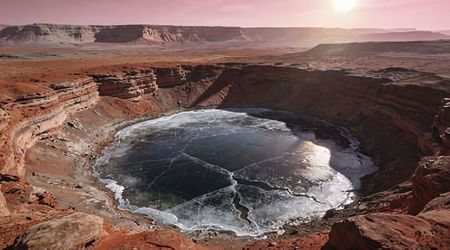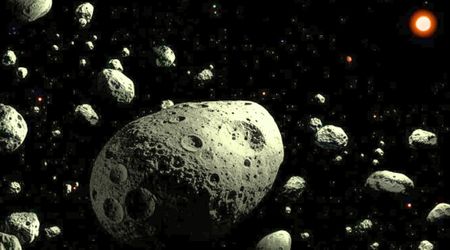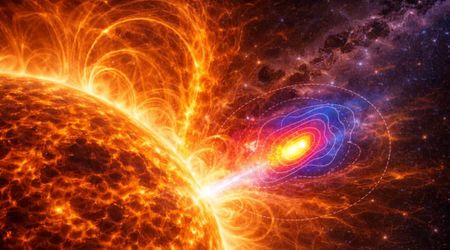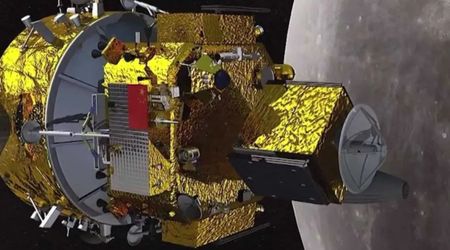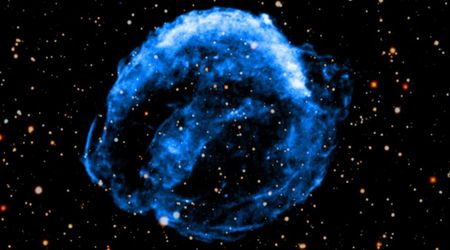Scientists have finally discovered how Martian lakes could exist without a warm climate
A new study has highlighted the reason that may have allowed ancient lakes on Mars to remain liquid beneath the surface, despite the cold climate.
7 hours ago
Vera Rubin Observatory finds asteroid nearly the size of 8 football fields spinning every two minutes
A massive 710-meter asteroid named 2025 MN45 has broken records as the fastest-rotating object of its size ever detected.
10 hours ago
Scientists solve a decades-old mystery by finding the hidden source of solar flare gamma rays
NJIT researchers have identified a class of high-energy particles responsible for the Sun’s mysterious and long-lasting gamma-ray bursts.
11 hours ago
China eyes lunar water ice as Chang’e 7 gets ready for the Moon's south pole
China’s Chang’e-7 mission will explore the Moon’s south pole, searching for water ice and future base sites.
12 hours ago
NASA’s Chandra stitches decades of data on supernova remnant into its longest video yet
NASA’s Chandra video reveals 25 years of change in Kepler’s supernova remnant.
1 day ago
Astronomers witnessed black hole shredding a massive star like it was 'preparing a snack for lunch'
The rare event has been labeled as one of the brightest events ever observed by mankind.
1 day ago
Jupiter’s moon Europa may lack geological spark needed for life, new study finds
New evidence suggests Europa’s seafloor may be a geologically dead wasteland, lacking the volcanic energy necessary to sustain life.
1 day ago
Did a giant impact help spark life on Earth? New study backs the 'RNA world' hypothesis
A new experiment reveals how RNA might have formed on early Earth, indicating the protein synthesizer’s role in early life.
1 day ago
Scientists made the longest-ever observation of a super-active solar region—and the results stunned them
The researchers imaged the active region NOAA 13664, which triggered the strongest solar storm observed in the last twenty years in May 2024.
2 days ago
NASA's Hubble Space Telescope confirms first-ever failed starless galaxy made of dark matter
The object, nicknamed Cloud-9, is a relic from the early days of the universe.
2 days ago
NASA's IXPE successfully studies a distant white dwarf star for the first time in history
The breakthrough study made use of IXPE's unique X-ray polarization feature.
2 days ago
Astronomers finally managed to measure the mass of a 'rogue' planet—it's a lot like Saturn
Situated roughly 10,000 light-years from Earth, the planet lacks a parent star and instead drifts solo through space.
3 days ago
What would happen if a black hole appeared near Earth?
Despite their name, black holes aren't empty voids but are actually massive amounts of matter packed into an infinitesimally small space.
3 days ago
International scientists to collaborate on project worth millions to film black holes in 3D
The TomoGrav project will pair deep-space data with advanced UK AI to film the violent dance of plasma and gravity.
6 days ago
Sensitive radio observations looked for technosignatures on 3I/ATLAS and found silence
The search focused on narrowband signals used by all of humanity's spacecraft but found nothing.
Dec 31, 2025
NASA is tracking asteroid more than twice the size of Empire State Building as it approaches Earth
The asteroid is projected to make its closest pass on February 14, 2026, and is classified under the "Potentially Hazardous Asteroids" umbrella.
Dec 31, 2025
Ancient Chinese text about a comet may have solved the mystery of 'The Star of Bethlehem'
For centuries, the biblical account of a celestial body leading the Magi to the birthplace of Jesus has baffled historians.
Dec 30, 2025
Supermassive black holes may be surprisingly picky eaters, new study finds
Using the ALMA telescope in Chile, an international research team examined seven pairs of merging galaxies to come to the conclusion.
Dec 30, 2025
Dark matter may be made of star-sized objects instead of tiny particles, new study suggests
The search for dark matter has been largely unsuccessful so far. But now, scientists think they know where to look for it.
Dec 29, 2025
Hubble spotted two cores in a nearby galaxy—now James Webb may have caught the reason in action
Hubble had confirmed that the galaxy had two nuclei. The origins of them, however, had remained a mystery.
Dec 29, 2025
